6 mushroom growing mistakes to avoid for a fruitful feast of fungi
Uncover the big mushroom growing mistakes to avoid for earthy edible pleasures with oysters, buttons, shiitake and much more besides


If it’s any consolation, making mushroom growing mistakes is something most growers will experience first-hand. Whether you’re off on your first forays by experimenting with oyster, button or shiitake cultivation, or walking on the wilder side with the chicken of the woods or hedgehog (lion’s mane) varieties, it’s easy to slip up on the journey from substrate to dinner plate. Take comfort from the fact that you aren’t the first, and you certainly won’t be the last. Still, if you take heed of the wisdom of our experts, you’ll definitely increase your chances of ensuring plentiful and healthy yields of firm and meaty mushrooms.
The advent of mushroom growing kits and a ballooning range of friendly fungi choices has meant this curious crop is far easier to try out for yourself. But we won’t lie, knowing how to grow mushrooms is about embracing the idea of trial and error. There’s an element of a school science project at play when you immerse yourself in the world of growing mushrooms – and quite often things don’t go exactly to plan. That said, there are key mistakes you can avoid to guarantee top-notch novelty nourishment. From rushing to overreaching to simply skimping on moisture, this guide outlines the main pitfalls, along with practical expert tips to help you focus on putting the fun into fungi.

Chanterelle and hedgehog varieties are within reach if you avoid key mushroom growing mistakes
6 mushroom growing mistakes to avoid for tasty, nutritious fungi
You don’t need lots of tricky or expensive tech to create the ideal growing conditions for the best mushrooms: just healthy, clean ingredients. By the same token, you needn’t think too creatively about kitchen garden ideas and elaborate techniques to cultivate the finest fleshy crops – and you don’t need oodles of space, either. Understanding the language of mushrooms is one of the key ways to prevent disaster. So it helps to get familiar with words like ‘spores’ (akin to seeds) and ‘spawn’ (seedlings) as well as ‘substrate’ (growing materials or foodstuffs). Beyond that, you just need patience, practice and the wisdom of these six big mushroom growing mistakes to create an abundance of gourmet nibbles.
1 Misjudging your commitment level
One of the biggest mushroom growing mistakes that amateur enthusiasts make takes place before the practical side of things even begins. It’s based on our own expectations of what we are looking to achieve with our mushroom journey, and how we best go about it. ‘I would say that the biggest mistake folks make when planning to grow mushrooms is not thinking enough about what kind of commitment they want to make,’ says Nikhil Arora, co-founder of Back to the Roots. The advent of organic mushroom kits from Back to the Roots and other suppliers has given more people access to the idea of growing mushrooms, which is a good thing. But it has also perhaps confused potential growers about how multifaceted growing can be, and what is needed in each case.
Before jumping in, give some thought to the type of mushroom you’d like to grow, as this will determine the substrate and manner of production (whether that’s a kit, an eco-straw block, coffee grounds or a prepared log from Etsy or similar). Kits are an excellent starting point for beginner projects where your commitment level is necessarily low. Once you have more confidence, you can progress to growing mushrooms with fruiting blocks and inoculating substrates, building your commitment levels organically and with confidence.
As a straightforward entry-level project, Nikhil suggests growing oyster varieties from a pre-inoculated kit for fresh mushrooms in 10 days. Where you are willing to spend a bit more time taking care of fungi, Nikhil recommends shiitake or lion’s mane varieties, which take a few weeks. And when you’re feeling ready to grow from scratch, you can get some spawn from Etsy or similar, plus some substrate. ‘However, this can take longer, from two-five months for your first mushrooms,’ says Nikhil. ‘So make sure you know yourself and how much you want to put into this, so you don't get discouraged along the way.’

Nikhil Arora is the co-founder of Back to the Roots, which evolved from an urban mushroom farm in Oakland, CA to an award-winning national brand. Along with co-founder Alejandro Velez, he is on a mission to make organic home-growing accessible and easy for all. Their line of organic kits, seeds and raised beds is distributed in over 10,000 retail locations.
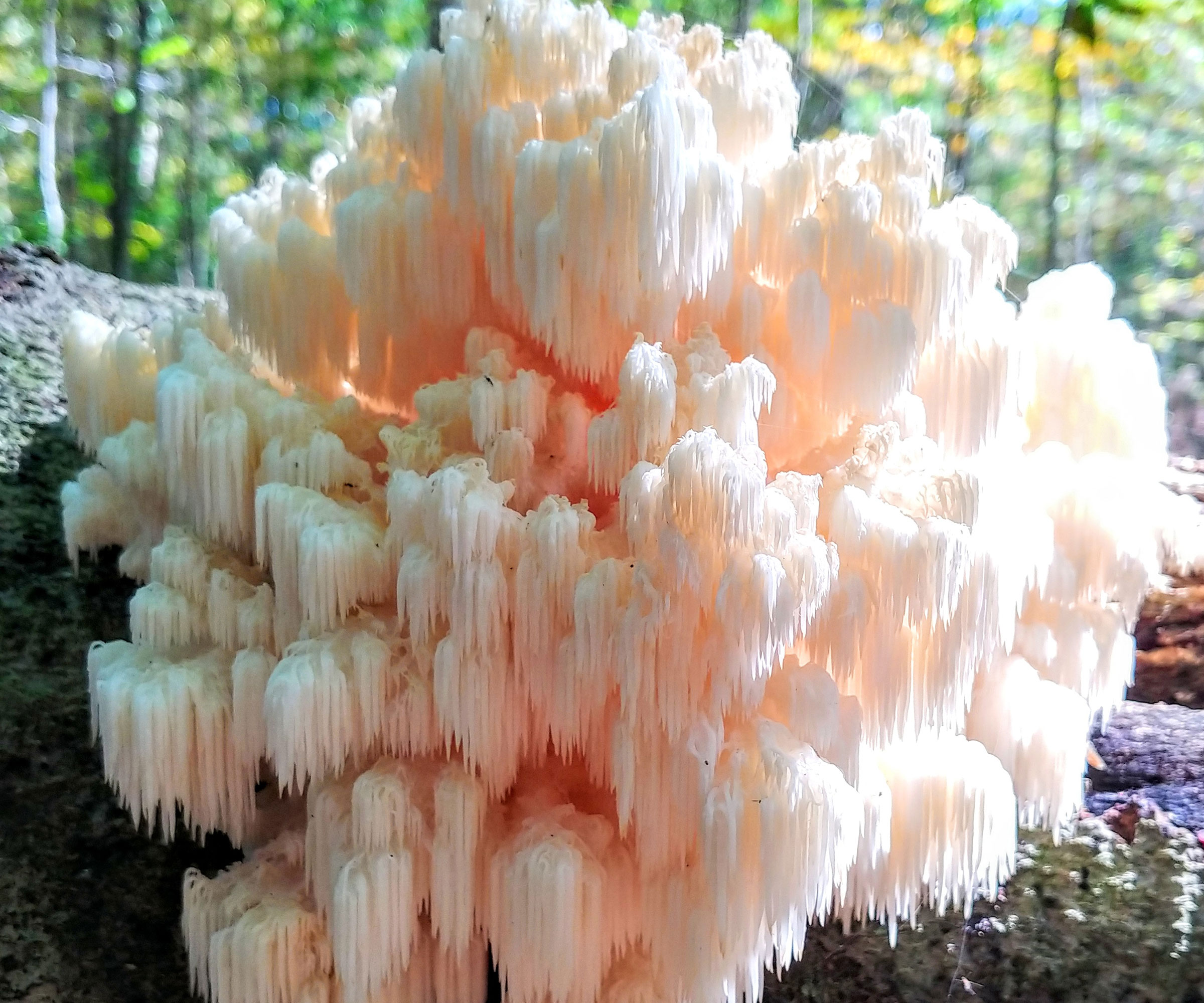
Kits can help you grow unusual varieties like lion’s mane (aka the pompom mushroom)
2 Miscalculating the life cycle of mushrooms
Following on from commitment level, another of the most common mushroom growing mistakes involves making decisions based on a lack of understanding about life cycles. While it is not necessary to have an extensive scientific knowledge of fungi before embarking on your first projects, it is important to have a sense of the basic process and how that process can be manipulated by external factors. A failure to comprehend that, and how it differs between breeds, can lead to rushing (and thereby spoiling) the process before it really has a chance to get anywhere. And while a craving for fast growing vegetables is not a crime, a different approach is needed if you want to get the most from mushrooms.
As we have pointed out, an affinity for the language of mushrooms can only be a good thing – and it doesn’t have to be hard work. The more you know about the interplay of basic materials, mushroom choices, and how they are affected by environmental factors, the more fun (and success!) you’ll have. So don’t be afraid to get acquainted with spores, and how to create the best conditions for kickstarting mycelium (the roots or threads that produce mushrooms). These fruiting roots rely on a specific set of conditions, ranging from substrate choices to carbon dioxide levels. And yes, the speed at which fruiting occurs depends on the mushroom variety you select. From the initial release of spores to the creation of mycelium, and the maturing of mushrooms to possibly releasing new spores and starting the process over again – knowledge is undoubtedly power.
If you grow oyster mushrooms or a quick-developing fungi, this life cycle is far more rapid than with a wine cap (stropharia), a morel or (at the highest end) a truffle. Certain substrates, like coffee grounds and straw-based compounds, prompt growth at different rates to logs. Opting to grow indoors or outside adds another level of variation. And whether or not you use a specialist kit can influence the rate at which mycelium develops and ‘colonizes’ the feeding substrate. ‘With some kits, mycelial growth is already induced,’ says Homes & Gardens fruit and veg expert Lucy Chamberlain. ‘Others require you to inoculate the substrate (be that straw or paper-based) or impregnate with spawn (as with specialist logs),’ she adds. ‘Inoculated kits can yield in four weeks, while logs may take months to bear a harvest of the best mushrooms.’
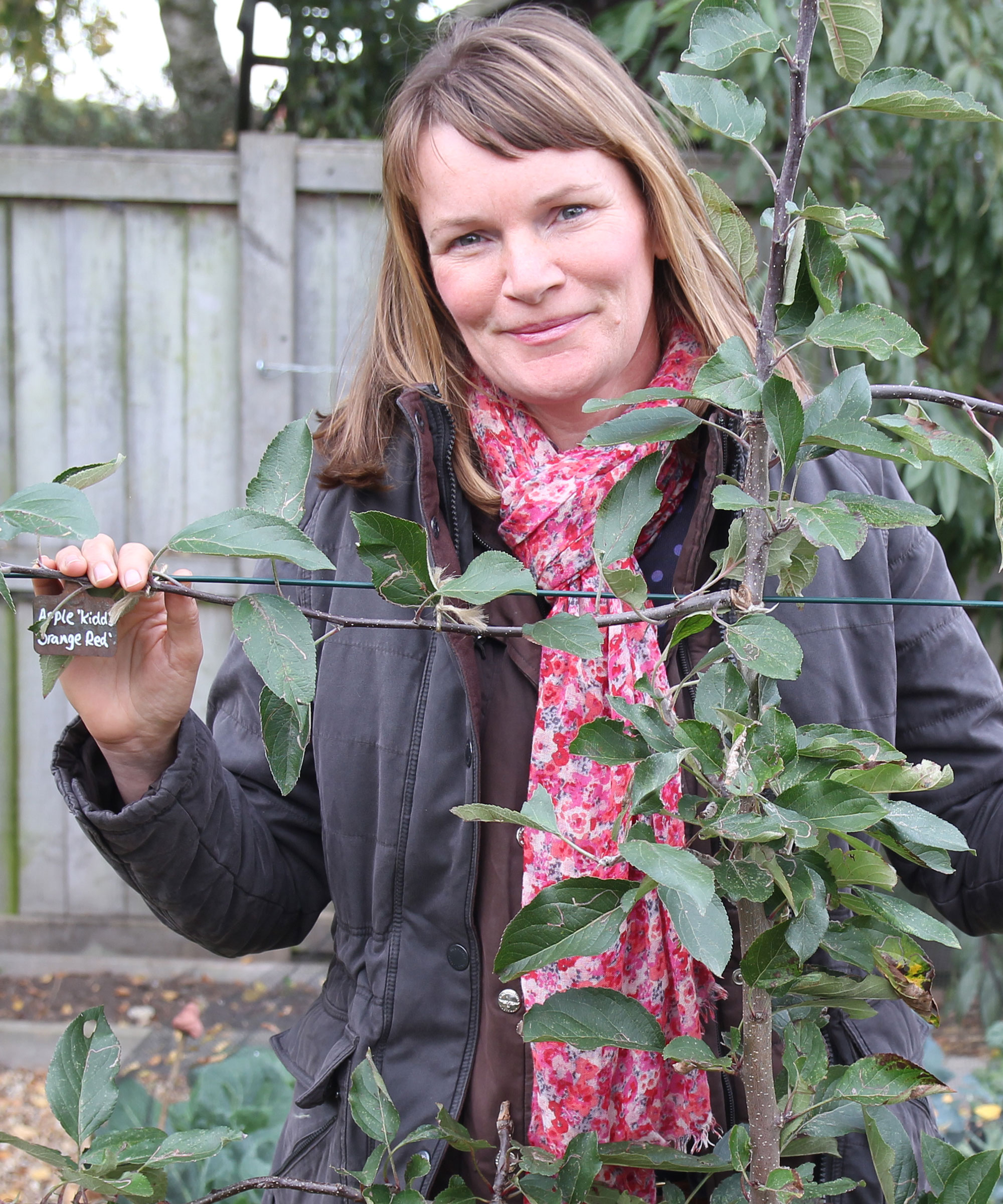
Lucy was a Horticultural Advisor at RHS Wisley and writes regularly for The Garden, Gardeners’ World, The Guardian and Amateur Gardening. She’s also the author of RHS Step by Step Veg Patch, which covers 50 types of fruit and veg. She is an avid mushroom enthusiast and loves finding new ways to grow edible fungi.
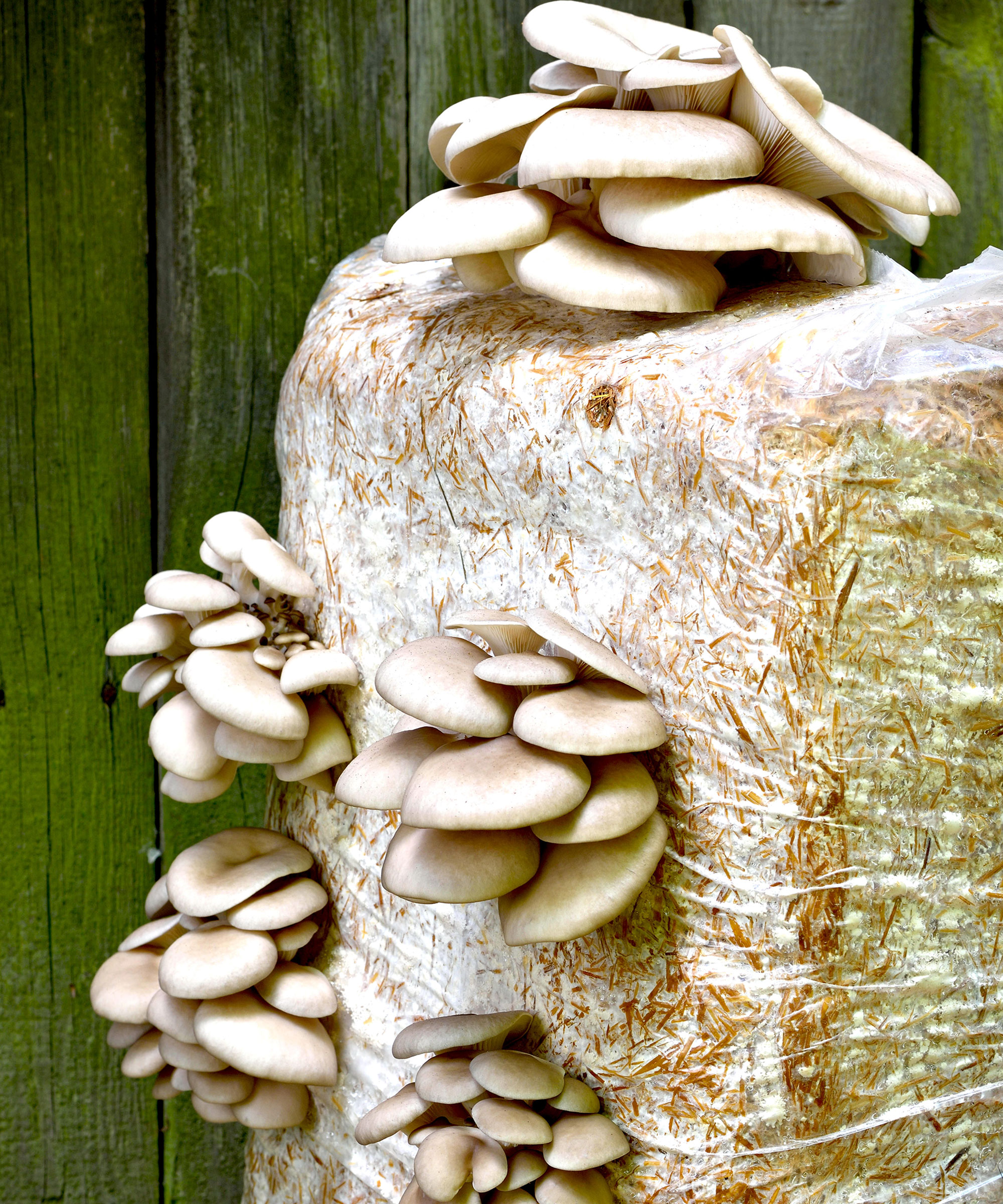
Oyster mushrooms (like these growing on ecological straw bales) are fast developing fungi
3 Trying to grow mushrooms in the wrong place
While there are a host of options with mushroom varieties, materials and growing spaces, you can’t apply a ‘one size fits all’ approach. If you are using kits, you are free to grow inside as long as the instructions don’t advise otherwise. Where damp, fresh conditions are advocated, several varieties are naturally disposed to prefer the outdoors. Of course, available space has to be a determining factor – but research your preferred mushroom and, as far as possible, give it the optimum conditions it needs to thrive.
‘You could fill a shady, damp corner of a sizable plot with hardwood logs impregnated with shiitake spawn,’ says Lucy. ‘Or you could grow Indian oyster and coral fungi, if you have softwood logs.’ Moist chip-mulched low maintenance garden borders and compost heaps offer ideal growing conditions for the likes of shaggy ink caps and King Stropharia fungi. If you don’t have masses of space, you still have options, says Lucy. ‘You can grow oyster mushrooms on a loo roll or a dog-eared paperback!’ The main thing is to make sure your mushroom variety is happy with both the substrate and environment you choose.
As long as you recreate the conditions preferred by your fungi of choice, you can have success growing mushrooms in a spare room or basement, garage or shed – and depending on breed, you can use buckets, bags or jars. Portobello and button mushrooms are happiest in compost, shiitake like logs and straw, and oysters are fine in coffee grounds or straw. Wherever you grow, make sure it is dark and damp. And don’t forget to ensure it is loaded with all the nutrients it needs to survive and flourish.
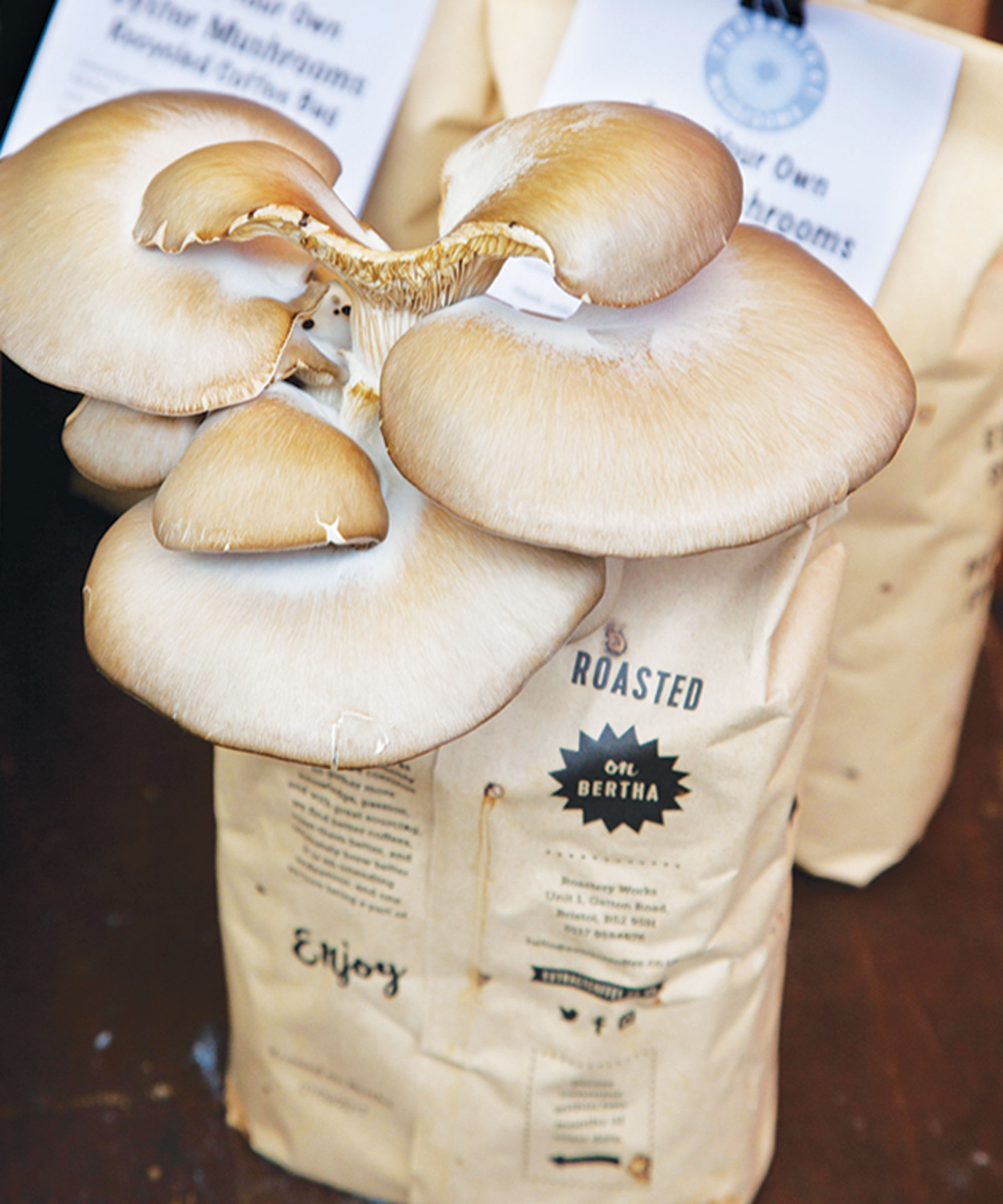
You can grow mushrooms like oysters quite easily on bags of waste coffee grounds
4 Misjudging the moisture level and temperature
Failure to harness the optimum moisture and temperature levels is perhaps the most damaging of all possible mushroom growing mistakes – but it is one that is possible to check and correct. Again, it primarily relies on knowing your preferred mushroom selection’s native climate – then replicating that as closely as possible. If you’re used to crops where your biggest worry is knowing when to water, this can be a learning curve, but it is critical to growing the best mushrooms.
‘One big mistake people make is growing mushrooms in a dry environment, such as near a refrigerator vent or a floor vent,’ says Nikhil Arora. ‘Humidity is key: if you’re in a dry area (like the High Rockies) or near a dry indoor environment, then double your regular watering or use a humidity tent.’ Soft plastic tents in cube box such as this one and perpendicular box styles from Amazon and other suppliers mimic native conditions for oysters, shiitake and so on. ‘Adequate and constant moisture is a must,’ agrees Lucy. ‘Indoors, keep misting and spraying walls, and make sure any bags are kept damp. A humidifier can automate the process to ensure best fruiting.’ You might also find it helps to invest in a humidity meter. Just don’t let your project sit in water, or you risk rots or molds.
Depending on the mushroom variety, you’ll need to maintain an even temperature below 60°F (although some, like oysters, prefer it closer to 70-80°F). You may also need to schedule a temperature drop to kickstart the fruiting stage. ‘Many mushrooms benefit from a chilling period to switch from producing the fuzzy mycelium that penetrates the woody tissues to the fruiting bodies that grace your frying pans,’ says Lucy.
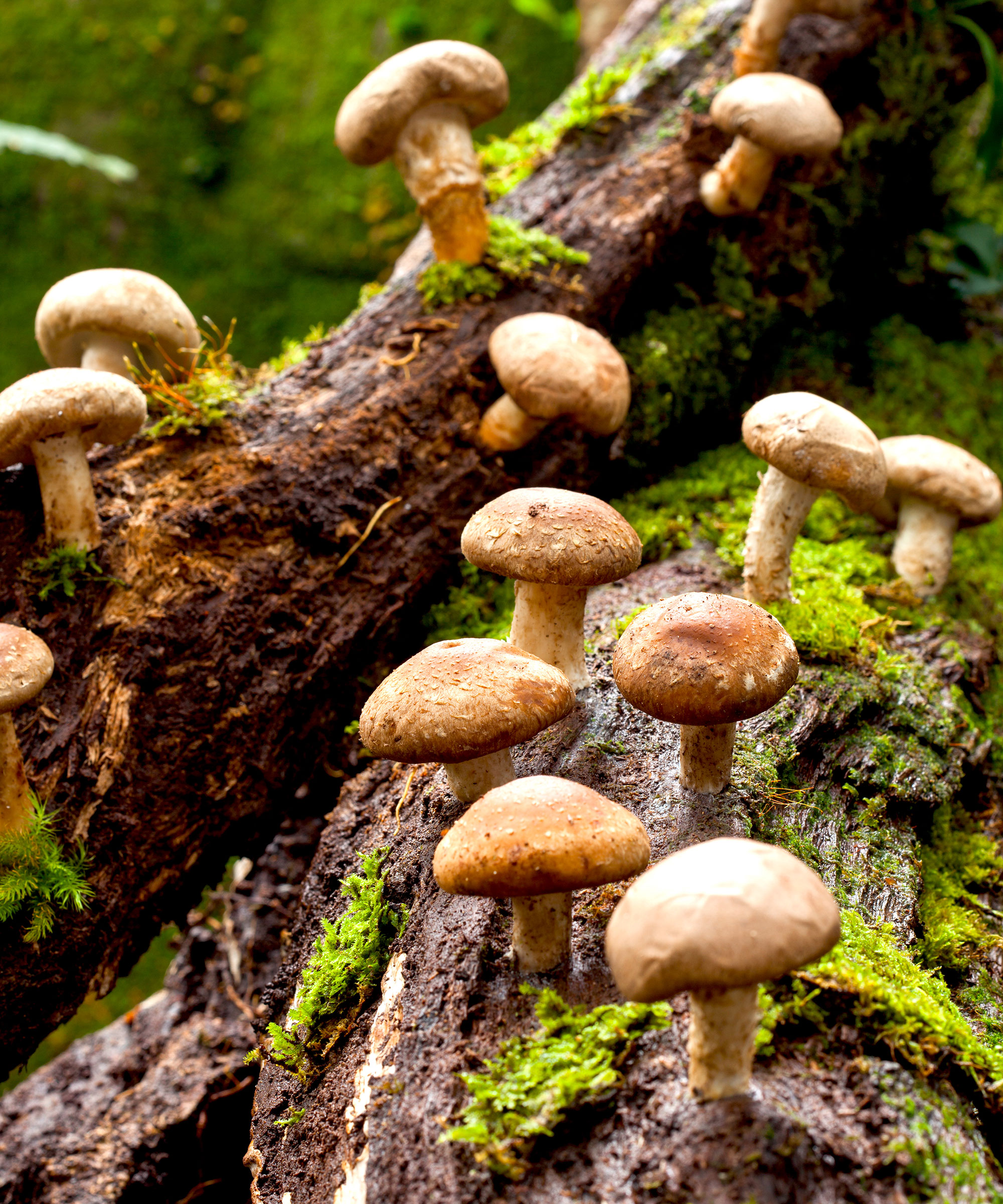
Shiitake grow well on logs if you are able to maintain the correct levels of moisture and warmth
5 Failing to maintain sterility and good air flow
As well as monitoring a delicate balancing act of light, temperature and moisture, you also need to maintain good levels of fresh air flow. Make sure you have the means to improve air quality indoors if growing mushrooms under glass. Regular fanning and ventilation can help to give growing fungi the oxygen it needs. If growing in a greenhouse, make sure you can easily adjust ceiling vents (and ideally side or louvre vents) to ensure the best mushrooms. If you neglect this crucial detail, fungi can get long and leggy. Maintaining a good air flow also helps reduce the risk of disease. But don’t forget the balancing act: too much exposure to a source of good air flow, and mushrooms run the risk of drying out.
Neglecting sterility is one of those mushroom growing mistakes that you might only become aware of when it’s too late. Mycelium color can give you a clue. When healthy, it usually shows as white. But if it presents as orange, green, yellow or black, your project may be compromised. To minimize the risk of contamination, keep your hands clean and always use clean materials. ‘You also need to ensure that substrates are sterile, and that any inoculation needed is done in sterile conditions,’ says Lucy. ‘Most often, kits supply inoculated substrate, but some offer liquid cultures injected via a needle and syringe,’ adds Lucy. You can also try all-in-one growbags like this one and sterilized substrate from Walmart and other suppliers for peace of mind in growing the best mushrooms.
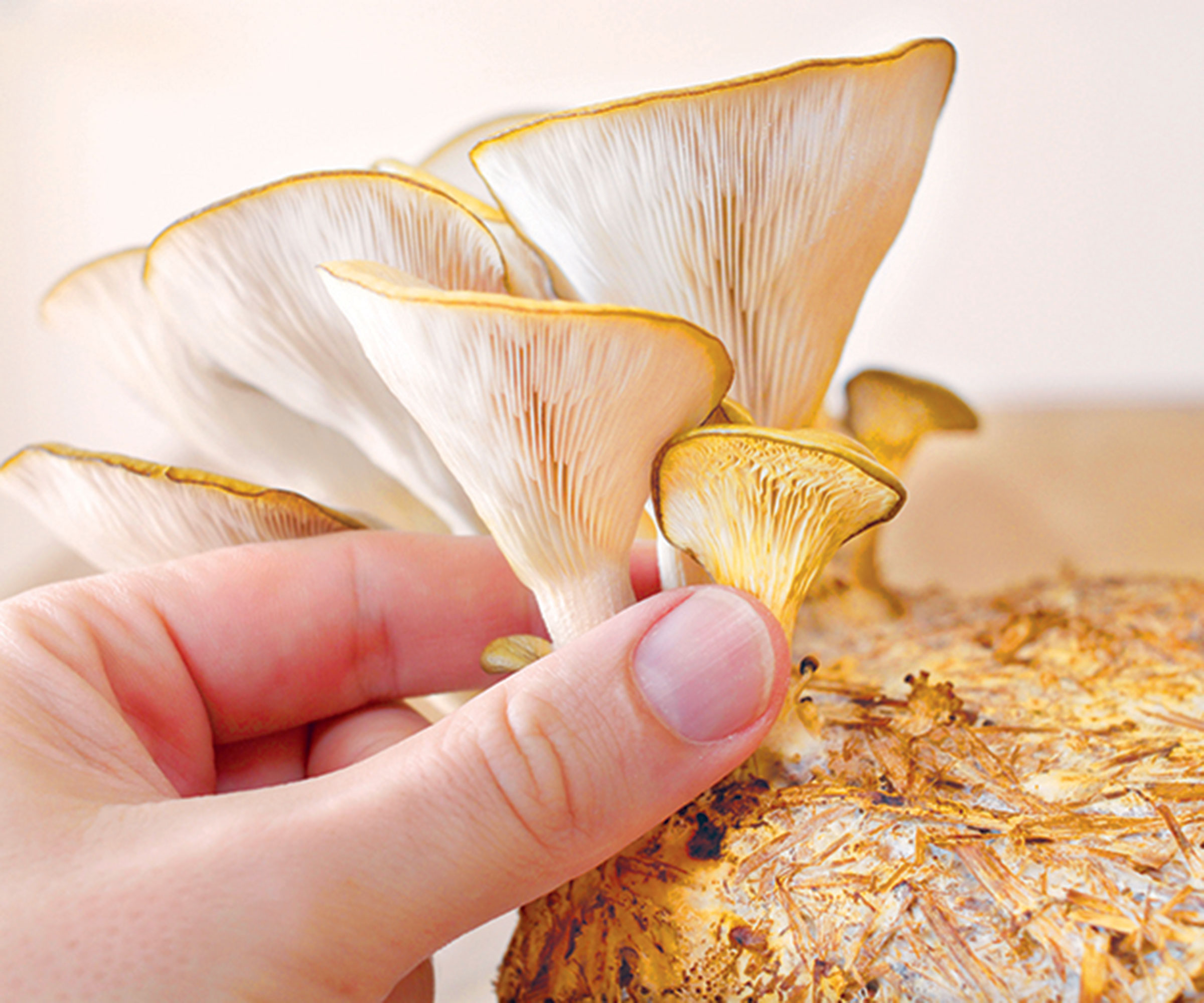
Making sure materials like straw are sterile will increase chances of successfully growing mushrooms
6 Harvesting at the wrong time
Perhaps the most frustrating of all mushroom growing mistakes is misjudging time to harvest. While growth is often surprisingly vigorous once the mycelium starts to fruit, development times do vary. As we have already explained, some inoculated kits burst forth with yields inside a matter of weeks, whereas log-based fungi can take months.
To avoid silly harvesting mistakes, familiarize yourself with your own specific mushroom type, and don’t make assumptions based on any others you might have grown. Along with understanding life cycles (as described above), the material and process you use also affect growing times. The amount of lignin (essentially, food) in wood-based projects can slow things down further. And time of year may also impact growth; while some mushrooms prefer cooler conditions, there are exceptions (oysters prefer it much warmer). September-November are traditionally the most successful times for growing mushrooms, but you may find warmer months reap faster turnarounds for certain types as long as they are in shade and kept moist (pink oysters are tropical in origin).
Exactly when you harvest comes down to finding that perfect window between too soon (when yields are low) and too late (when fruits have dried out). As a guide, it’s best to harvest while the edges of the caps are facing down. ‘Harvest oysters, pink oysters and chicken in the woods before those caps turn upwards,’ says Lucy. ‘Harvest by plucking with your fingers, or by using a sharp knife to cut from the base of the stem.’
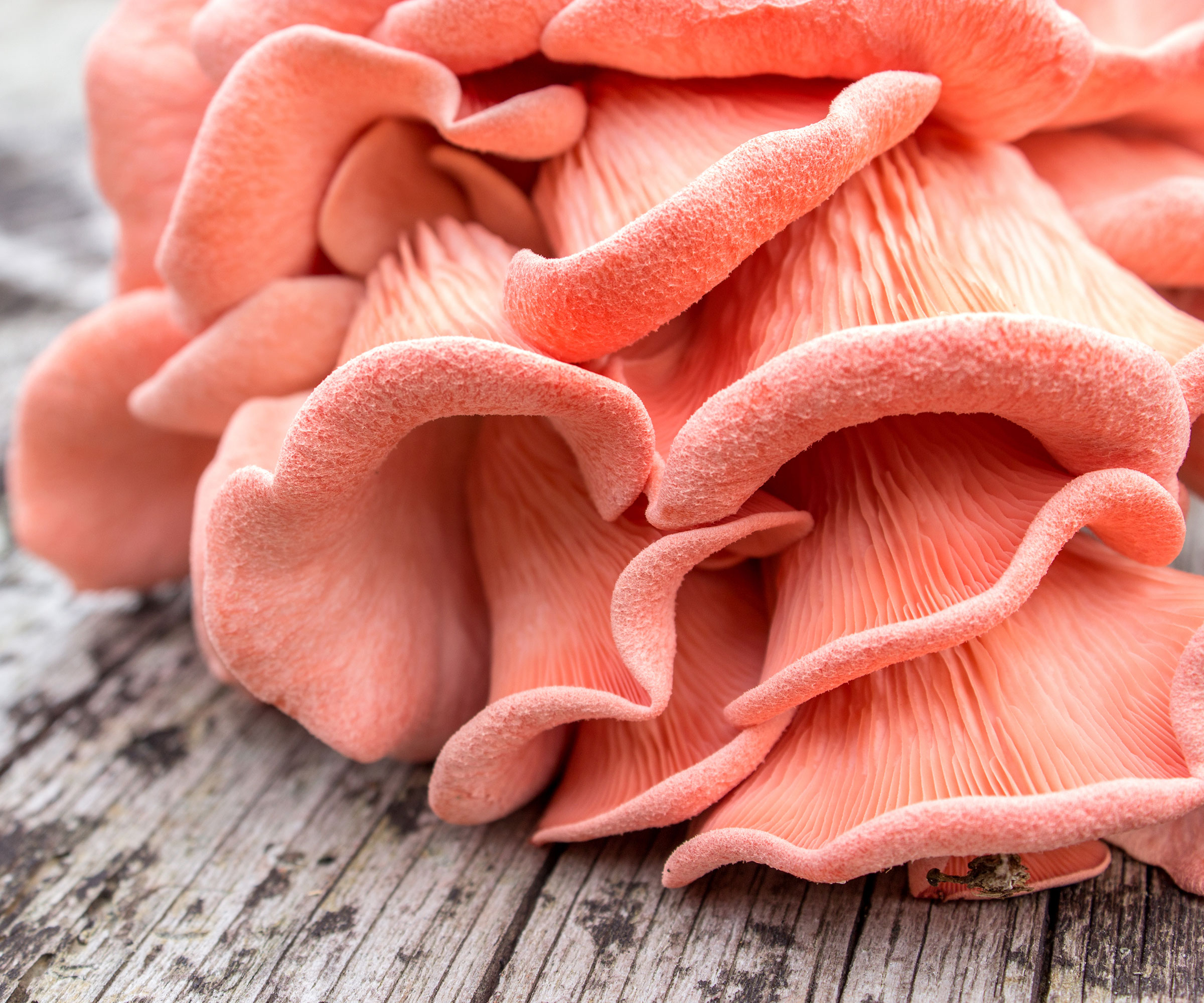
Pink oysters are some of the fastest developing mushrooms to harvest and can reach maturity with three or four weeks
FAQs
What are the best mushrooms for beginners?
According to the Mushroom Appreciation group, there are over 10,000 known types of mushroom, with 300 being edible. To minimize the risk of mushroom growing mistakes, it’s ok to start with something low maintenance, hardy and quick-growing. Oyster mushrooms (Pleurotus ostreatus) come in a range of shapes and colors and are especially easy growing and productive in a range of substrates like compost, coffee grounds, paper, sawdust blocks and eco-straw bales.
Which mushrooms are poisonous?
It’s obviously very important to have a handle on any poisonous plants you might be growing. However, as long as you stick to mushroom kits and growing materials sourced from a reputable mushroom company or specialist supplier, there is little danger of growing something poisonous.
It is more of a risk if you are foraging mushrooms grown in the wild. Some kinds (like shaggy inkcap) are safe, but many others can cause sickness or worse. Some of the most toxic include destroying angel, fool’s funnel, funeral bell and death cap, with side effects ranging from blurred vision and cramps to kidney and liver failure. If you are not sure, leave well alone and stick to growing your own safe fungi.
Give your mushroom growing projects plenty of time. Even with the best mushrooms, some forms of mycelium (the threads that initiate fruiting) can take longer to develop than others. This can be down to several factors, including moisture levels, temperature, air levels and amount of spawn present. If you’re used to quick-maturing crops like peas and lettuce, the waiting game is tough, but be patient and don’t lose faith.
Finally, have fun, says Nikhil. ‘Mushrooms are exciting, and there are plenty of varieties and techniques to try,’ he adds. Embrace the unknown, and even the things that don’t go to plan can be educational. Keep trying, learn from those mistakes and, above all, enjoy the adventure.
Sign up to the Homes & Gardens newsletter
Design expertise in your inbox – from inspiring decorating ideas and beautiful celebrity homes to practical gardening advice and shopping round-ups.

As assistant editor of Amateur Gardening magazine, Janey's gardening passion was fostered from an early age, when her amazing mum had her deadheading hydrangeas, mulching roses, and propagating strawberry plants from runners for school open days. She's also taken part in lots of conservation and rewilding projects for the RHS and TCV as a way of exploring her horticultural horizons.
-
 Ina Garten's storage pantry is an insightful window into all of the best cookware used by the chef – and it's easy to recreate on your kitchen shelves from $48
Ina Garten's storage pantry is an insightful window into all of the best cookware used by the chef – and it's easy to recreate on your kitchen shelves from $48The beautiful dishware in The Barefoot Contessa's Hamptons pantry showcases the tools she uses most often to cook – this is exactly how you replicate it
By Sophie Edwards Published
-
 Extend the lifespan of your appliance with 5 simple but crucial washing machine maintenance tips
Extend the lifespan of your appliance with 5 simple but crucial washing machine maintenance tipsFrom cleaning the filters to keeping the door open, experts reveal the washer tips they swear by
By Andy van Terheyden Published